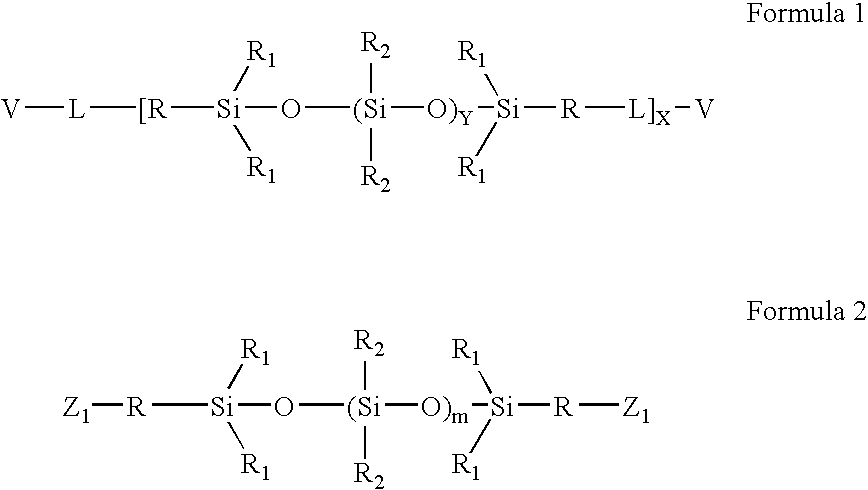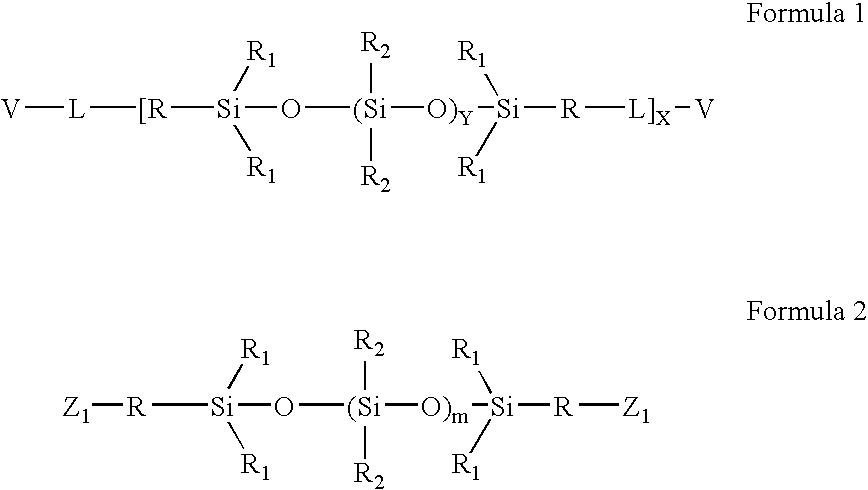High refractive index aromatic-based prepolymer precursors
a prepolymer and high refractive index technology, applied in the field of prepolymers, can solve the problems of less popularization of more rigid iol implants in the market, increased incidence of postoperative complications, and less desirable than other materials with respect to minimal incision size, and achieves high refractive index, high elongation, and high strength for durability.
- Summary
- Abstract
- Description
- Claims
- Application Information
AI Technical Summary
Benefits of technology
Problems solved by technology
Method used
Image
Examples
example 1
Preparation of Hydroxybutyl-terminated Copolymer of Dimethylsiloxane and Diphenylsiloxane
1,3-bis(hydroxybutyl)tetramethyl disiloxane (33.70 g, 0.118 mole), dimethyldimethoxysilane (403.18 g, 3.25 moles) and diphenyldimethoxysilane (272.33 g, 1.08 moles) were added in a one-liter round bottom flask. Water (78.29 g) and concentrated hydrochloric acid (11.9 mL) were then slowly added to the flask. The contents of the flask were refluxed for one hour. Methanol (253.3 mL) was distilled from the contents. Water (160 mL) and concentrated hydrochloric acid (130 mL) was added to the flask. The contents of the flask were refluxed for one hour. The contents of the flask were then poured into a separatory funnel. The silicone layer was separated, diluted with 500 mL ether and washed once with 250 mL water, twice with 250 mL 5-percent sodium bicarbonate aqueous solution and twice with 250 mL water. The final organic layer was dried with magnesium sulfate, and then vacuum stripped at 80 degrees C...
example 2
Preparation of Methacylate-capped Prepolymer of Polysiloxane Containing Both Dimethylsiloxane and Diphenylsiloxane Units
A 500-mL round bottom flask equipped with reflux condenser and nitrogen blanket was charged with isophorone diisocyanate (5.031 g, 0.0227 mole), the hydroxybutyl-terminated copolymer of dimethylsiloxane and the diphenylsiloxane from Example 1 (51.4465 g, 0.0189 mole), dibutyltin dilaurate (0.1811 g) and methylene chloride (150 mL). The flask contents were refluxed. After about 90 hours of reflux, the isocyanate was found decreased to 16.2 percent (theoretical 16.7 percent) of original. The contents of the flask were allowed to cool to ambient temperature. Hydroxyethyl methacrylate (HEMA) (1.1572 g) and 1,1′-2-bi-naphthol (5.7 mg) were added to the flask and stirred. After seven days, NCO peak disappeared from IR spectrum and the reaction was terminated. The product was obtained at quantitative yield after removing solvent.
example 3
Preparation of Hydroxybutyl-terminated Polymethylsiloxane with Fifty Percent Phenyl Content
1,3- bis (hydroxybutyl)tetramethyldisiloxane (13.18 g, 0.474 mole) and dimethoxyphenylmethylsilane (238.08 g, 1.306 moles) were added to a one-liter round bottom flask. Water (23.58 g or 1.31 mole) and concentrated hydrochloric acid (4.8 mL) were then slowly added to the flask and the contents refluxed at 70 degrees Celsius for one hour. After refluxing, methanol (69.2 g) was distilled from the flask and 44 mL of water and 44 mL of concentrated hydrochloric acid were added to the reaction mixture. The contents of the flask were then refluxed for 3.5 hours prior to being poured into a separatory funnel. The silicone layer was separated, diluted with 500-mL ether and washed twice with 100-ml water, twice with 100 mL five percent sodium bicarbonate aqueous solution and twice with 250-mL water. The final organic layer was dried with magnesium sulfate, and then vacuum stripped at 80 degrees Celsius...
PUM
| Property | Measurement | Unit |
|---|---|---|
| refractive index | aaaaa | aaaaa |
| molar ratio | aaaaa | aaaaa |
| molecular weight | aaaaa | aaaaa |
Abstract
Description
Claims
Application Information
 Login to View More
Login to View More - R&D
- Intellectual Property
- Life Sciences
- Materials
- Tech Scout
- Unparalleled Data Quality
- Higher Quality Content
- 60% Fewer Hallucinations
Browse by: Latest US Patents, China's latest patents, Technical Efficacy Thesaurus, Application Domain, Technology Topic, Popular Technical Reports.
© 2025 PatSnap. All rights reserved.Legal|Privacy policy|Modern Slavery Act Transparency Statement|Sitemap|About US| Contact US: help@patsnap.com



